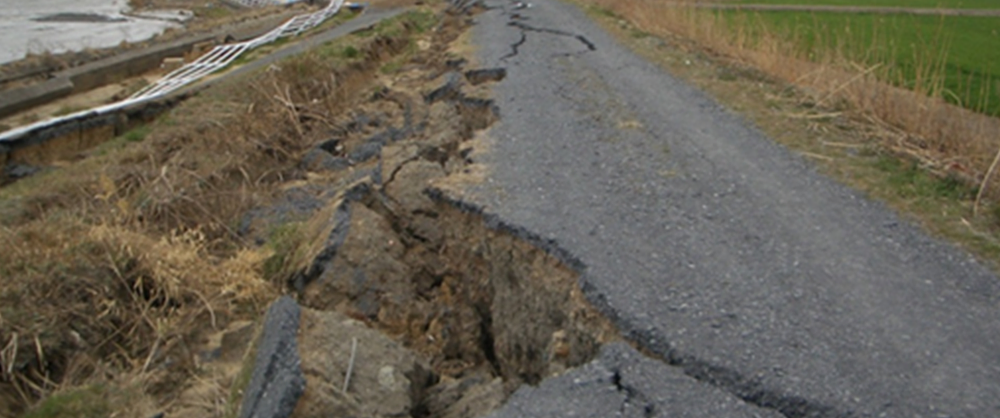
Infrastructure Engineering Geoenvironment
In the construction business, we provide a full range of technical services including investigation, analysis, design, and construction supervision related to geotechnical and geological engineering. Geotechnologies for ground, geosphere, groundwater, ground conservation, and earthquake disaster prevention are indispensable technologies for both domestic and overseas projects, and play a role as elemental technologies that support all fields.
The geo-environmental field covers soil investigation, testing, and analysis related to airports, soft ground, fill dams, foundation works, and shields; investigation and analysis for strengthening river structures and levees; earthquake disaster prevention analysis for airport civil engineering facilities, sewerage facilities, and river and coastal facilities against large earthquakes; geological, groundwater, and soil conservation investigation and analysis, impact assessment, and investigation of groundwater and soil conservation measures. We are working to add value in cooperation with each business unit while upgrading and differentiating our technologies based on the policy of "cultivating and developing the field of geotechnical foundations as a differentiated technology".
To ensure the safety and security of local communities, we are working on highly urgent projects to prevent and minimize damage from torrential rains, which are a cause of concern due to global warming; seismic studies related to projects to improve disaster prevention facilities in preparation for large earthquakes; and environmental vibration caused by soft ground. In addition, we provide a variety of complex and environmental geotechnical consulting services that are environmentally friendly, including compliance with the Soil Contamination Countermeasures Law, evaluation of environmental contamination risks such as tunnel excavation rock containing naturally occurring heavy metals, dredged sediment, and buried waste, and evaluation of groundwater, stream water, and water quality impacts associated with construction projects, in conjunction with design. We provide a variety of complex and environmental geotechnical consulting services that are tied in with design.

Engineering Services
Based on our extensive experience, we provide optimal solutions for soil and groundwater environments.
After identifying issues (stability, consolidation settlement, liquefaction, etc.) based on the type, function, and importance of the structure to be constructed on soft ground and the characteristics of the subject ground, we plan and conduct appropriate investigations and analyses to determine the need for countermeasures.
If countermeasures are deemed necessary, we will select the most economical and optimal construction method based on our advanced technical capabilities and extensive experience, while taking into consideration the purpose of the countermeasures, the physical properties of the target soil, and the impact on the surrounding area.
With the increase in urban density and the development of social infrastructure, including underground spaces, it is not uncommon for lifeline facilities and building structures, etc., to become congested, especially in urban development.
We plan and conduct the necessary investigations to study the impact on existing structures, conduct impact prediction analysis (FEM), and provide consulting services to determine the necessity of countermeasures based on the verification (displacement, stress, etc.) according to the structure. In addition, if necessary, we will develop a plan for dynamic observation during construction.
As the imminence of a major earthquake increases throughout Japan, the most effective way to protect precious human lives and valuable assets from earthquake disasters is to build earthquake-resistant structures.
Based on our extensive experience in seismic design, performance verification, and planning for airports, ports, rivers, roads, and water supply and sewage facilities, as well as our advanced analytical technology, we offer optimal solutions for protecting safe and secure lifestyles that are resistant to earthquake motion.
Construction work and vehicle driving on soft ground can repeatedly generate unpleasant vibrations in the vicinity, which can interfere with comfortable living.
We provide a full range of technical services, from investigation and measurement of environmental vibration caused by such soft ground, to analysis of its causes, and study and design of countermeasure works.
Accurate knowledge of the type, strength, and permeability of the foundation soil is important for the safe and economical design and construction of structures such as dams, tunnels, roads, buildings, and power plants.
The Japanese archipelago has a wide variety of landforms, including mountains, hills, and lowlands, as well as complex geological features such as accretionary bodies, volcanic regions, and faults. In addition, as an earthquake-prone region, there is an increasing need for seismic design and reinforcement measures to prevent liquefaction of the ground.
Based on our experience, human resources, and state-of-the-art technology cultivated through numerous projects, we collaborate with related design departments to identify ground-related problems and provide high-quality investigations and analyses.
Geological surveys have traditionally included geological mapping and borehole investigations. In addition to these, we conduct geophysical surveys such as seismic, electrical (2D resistivity), Rayleigh wave (surface wave), and radar surveys, as well as on-site permeability tests, velocity logging, and electrical logging using boreholes, in order to accurately determine the distribution and properties of ground types, weathering, fault fracture zones, and altered zones. We also conduct in-situ permeability testing, velocity logging, and electrical logging in boreholes.
In particular, tomographic analysis methods have been introduced for seismic and electrical surveys to improve the accuracy of the analysis.
Recently, there have been many cases of cave-ins in cavities directly under roads and in bunkers dug during the war. We believe it is important to accurately determine the distribution, extent, and scale of these cavities and the risk of cave-ins, and to consider countermeasure construction in order to ensure a safe and secure social life.
We provide evaluation of sinkhole risk and countermeasure technology based on the distribution and extent of cavities and surrounding ground characteristics, making full use of geophysical exploration methods such as radar and Rayleigh wave (surface wave) surveys that we have developed over many years.
Groundwater is generally of better quality than surface water and is widely used not only for drinking water but also for industrial and agricultural purposes. It is also highly resistant to earthquakes and other disasters and serves as an emergency water source. However, in coastal and island areas, saltwater intrusion from the sea can cause groundwater salinization, which can impair the use of wells and damage agricultural crops. There is also concern that rising sea levels associated with future global warming will further increase the impact and damage caused by groundwater salinization.
To address this problem, we propose a research plan that takes advantage of local characteristics to promote groundwater management and sustainable groundwater use in coastal areas. We will also use a numerical analysis model of advection-dispersion to reproduce the actual situation of salinization, predict the future, and formulate an effective countermeasure policy.
The issue of water inflow during mountain tunnel construction affects both tunnel construction and the use of surrounding groundwater and stream water. As attention focuses on evaluating and avoiding the economic risks of road projects, there is an increasing need to predict the impact of tunnels on the groundwater environment and implement drought countermeasures.
To address this issue, we provide technical services that include field surveys to clarify the distribution of groundwater potential around the tunnel construction area, and numerical analysis models that reproduce the potential distribution and actual flow conditions to evaluate the impact of tunnel excavation and the effectiveness of countermeasures.
The land where we live may be contaminated by toxic substances such as trichloroethylene (TCE) and hexavalent chromium (Cr6+) due to the production activities of factories and other facilities that were located there in the past, and the soil may be distributed or the groundwater may be contaminated. In addition, contamination by dioxins may be observed at former incineration sites. In addition, illegal dumping of waste materials is another cause of soil and groundwater contamination. We provide a comprehensive response to soil and groundwater contamination caused by human factors, including investigation, countermeasures, and monitoring.
Large-scale development projects such as tunnel and dam construction generate large amounts of construction by-products (excavated rock). When these excavated rocks are used as fill, acidic water may be generated, and arsenic (As) and lead (Pb) may be eluted exceeding environmental standard values. Similar risks may also be present in dredged sediment from rivers or sand deposited in dam reservoirs. These sources are naturally occurring toxic substances contained in rocks, but when leached in large quantities may cause environmental pollution. We evaluate such naturally occurring environmental pollution risks and consider reasonable countermeasures.
In accordance with the "Law on Special Measures Concerning Public Use of Deep Underground Space" promulgated in May 2000, large-scale use of underground space is contemplated in the future. In using underground spaces, there is a risk of chemical changes such as generation of oxygen-depleted air, acidification of groundwater, and exothermic reactions. Environmental changes associated with chemical reactions are also anticipated for ultra-deep underground utilization (e.g., geological disposal of nuclear waste, underground storage of CO2, etc.). We will predict and formulate responses to such environmental changes.


